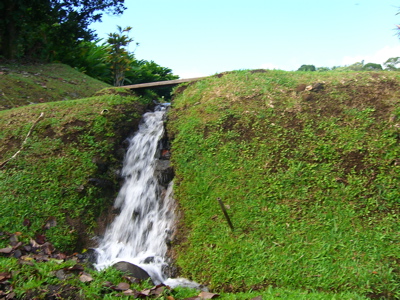 Hawaii
Trip 2006
Hawaii
Trip 2006 Hawaii
Trip 2006
Hawaii
Trip 2006 Monday,
December 18
Monday,
December 18I got us up at 6:00 to get checked out and actually on the road by 7:30, which put us in Paia (after driving back up through Central Maui, past the strange-smelling sugar factory) right at 8:00. We poked our head into a couple restaurants and stores that various guidebooks had recommended either to have breakfast at or to buy a boxed lunch for the ride at. Yes, we were going to drive the Road to Hana, supposedly the twistiest, turniest drive anywhere. Despite repeated warnings about the very low speeds needed for safety, and the terrible traffic, dangerous turnoffs, but exceedingly beautiful rainforest scenery, Robert wasn’t expecting much from this drive—we had just driven California’s Route 1 earlier this summer, after all, and we’d experienced both beautiful scenery and very turny roads.
While Robert gassed up the car at the Chevron in Paia, I went to the gas station next door, which advertised “Maui Fried Chicken” to investigate the dining options. After a peculiar conversation with a man in the gas station who was certain that I was looking for a restroom (which I wasn’t), I finally fled to the back of the gas station/convenience store and found the fried chicken/food area. The fried chicken itself looked sort of soggy and unappealing, but there was a wide selection of (fully-cooked) premade sushi and manupuas. For $4.15, I bought us a large piece of cooked ahi maki, two vaguely siu-mai-like dumplings, and a very large, yellow-colored steamed bao (manupua) filled with a moist, delicious coconut-milk-based yellow chicken curry. We ate these and the last of our mochi in the car as we started the drive east.
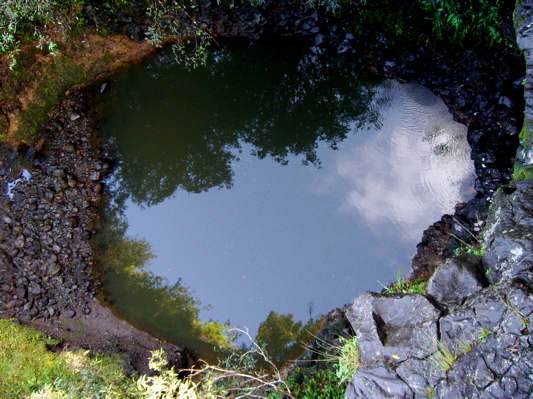
Above, the view of one of the reflecting pools from one of the many bridge on the drive. The drive itself turned out to be not as twisty as had been foretold, though the scenic overlooks and little trail walks were indeed lovely. We took one short walk that was very muddy, and we stopped several times to look at waterfalls by the side of the road or over the edge of the one-lane bridges.
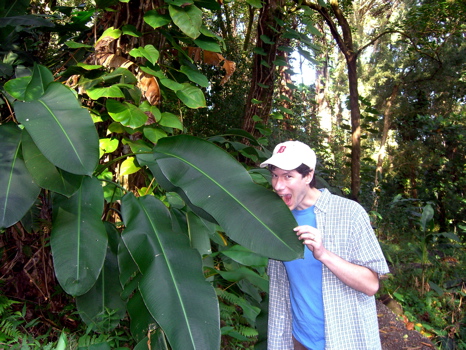
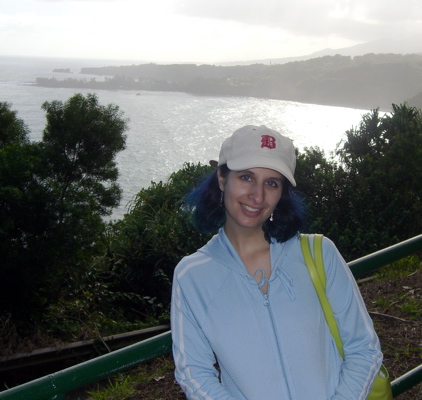
We stopped for a midmorning snack at the Nahiku Ti Gallery and snack shop, where we bought a smoked marlin taco and a slice of baked breadfruit. I loved the breadfruit, which Robert compared to a tasteless artichoke heart, and the taco was nice and juicy and smoky. We also bought coconut candy from the stand next door, after sampling all of their different flavors and their dried apple bananas. Closer to Hana, we stopped at a self-serve fruit stand (there are lots of these) and bought two apple bananas for $.25 each and a passion fruit for $.50.
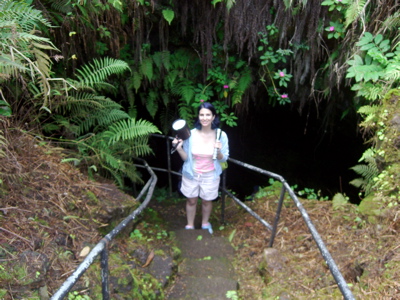
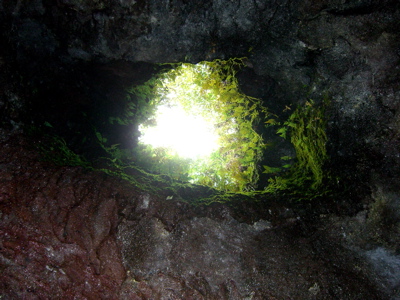
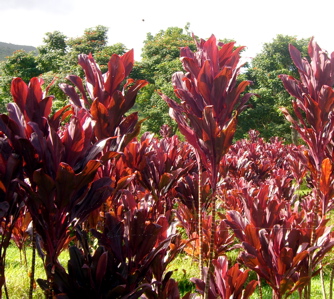
By far the highlight of the drive for me, though, was the self-guided tour of the Hana Lava Tube at the Ka’eleku Caverns, down Ulaino Road near mile marker 31. For some reason, I always love cave tours, whether they’re the gold-prospecting kind in the Black Hills of South Dakota or the Sea Lion Caves on the Oregon coast. Between loving cave tours and loving interesting volcanic features, we had to stop at the Hana Lava Tube.
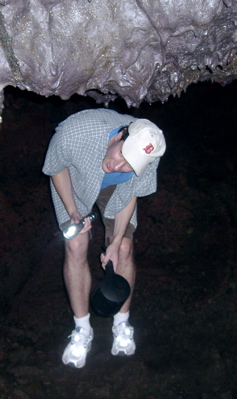
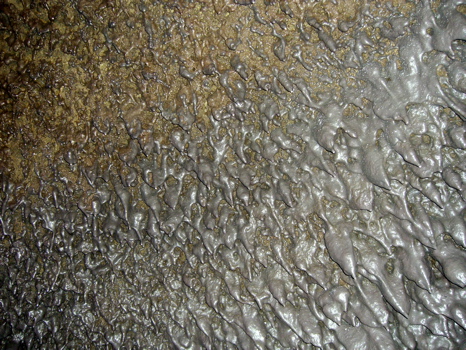
Admission for the two of us was $25, which was definitely worth it. We each got a large, sturdy flashlight—no flimsy tourist give-away here—to use for navigating through the cave, and each party also gets a single extra-large spotlighter lamp to light up whole areas of the cave for closer viewing or for picture taking. The tour was wonderful, and the lava formations were truly beautiful and amazing to see. I loved that the cave wasn’t really commercialized, and that the owner was so friendly and really cared about the place.
Past the lava tube, we stopped at a black sand beach with a sea arch and a blowhole, and, as Robert observed, more warning signs than he's ever seen in one place. It was beautiful, but a little rough for swimming, so we kept driving.
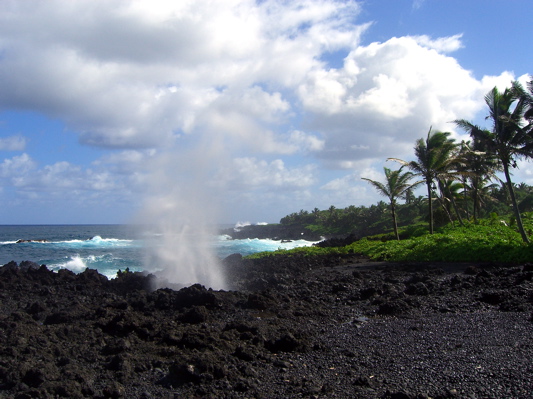
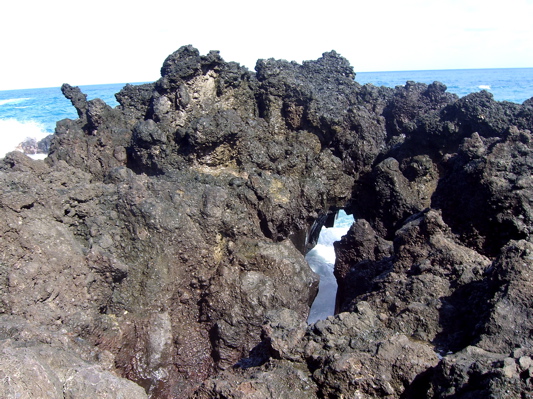
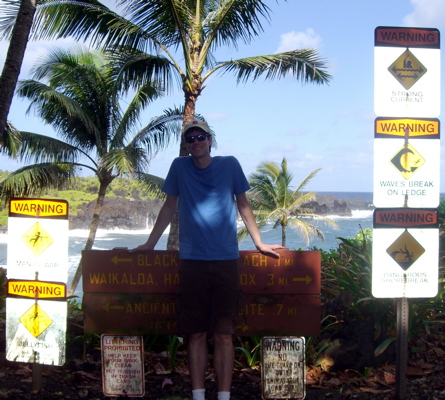
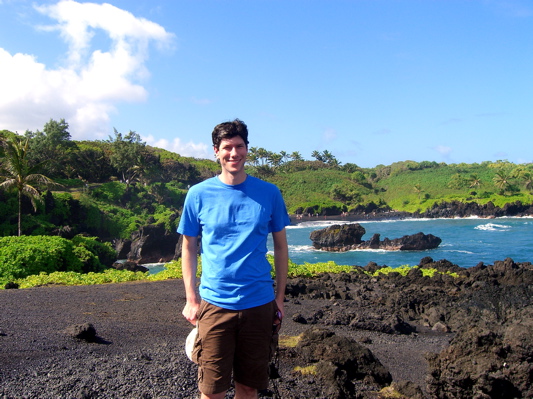
Once in Hana, we drove straight to the Hana Beach Park, another black sand beach where we relaxed while waiting for a haupia ice cream cone and a loco moco (a classic Hawaiian breakfast or lunch—a fried egg on top of a hamburger patty on top of rice, the whole thing slathered in brown gravy), and then enjoyed our food on the beach. While waiting for our food, a Chinese tourist walked up to the window and asked the woman working at Tutu’s, the little ice cream/burger stand, a bunch of questions in fragmented, but very polite, English. Sometime during this extremely protracted conversation, she dropped one of her printed-out pages on the ground. When she finished talking, I said, “Excuse me? Excuse me! You dropped a—” but the woman had darted away before I finished my sentence. Really, it was a spectacular exit—she darted left, and while I was calling and three other people looked stunned, she swung around in a quick u-turn and literally ran off to the right, almost immediately disappearing behind another building near the water. We all shrugged, and Robert and I started reading her paper—70% Chinese with some random English phrases. We laughed about what a great exit she’d made, truly fitting a criminal’s fast-getaway. As we were doing this, and still waiting for our lunch (Hawaiian food is not, generally, “fast” food, though the ice cream cone did come first, and it was creamy and delicious), I saw the same Chinese woman, driving a Jeep, with a man next to her, come back down the road past us. “Oh!” I yelled, waving the paper in the air, but they sailed on by. Robert observed that they were headed down a dead-end to the very end of the road at the beach, so they’d have to be coming back. He stationed himself next to the road, holding the paper, and sure enough, the woman and her husband came back into sight in another minute or two. As they came by this time, Robert waved and waved his hands, and then shoved the paper into the Jeep. The couple looked mildly surprised, but really, nowheres near as startled as one might think.
After our lunch, we walked around the beach a little and then drove back up the road to check in at our rented studio apartment. I reserved it online, and then they emailed me the combination for a box that contains the key to the door, so it was a very satisfying transaction with absolutely no human contact at all. The studio was cute and quite sufficient for the night; it wasn’t air-conditioned, but we were comfortable with the fan, and the ocean was just thirty feet away out the back door.
One thing I really liked about this property was that it contained an old ali’i heiau, a fish pond (actually on the state registry of historic locations), on the grounds, and we could walk around it and actually sleep right next to this centuries-old structure. The people who owned the land and the rental units had restocked it with fish, so Robert got to smile at them every time we came in or out.
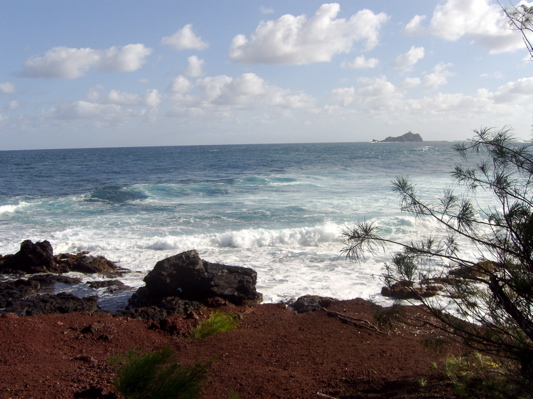
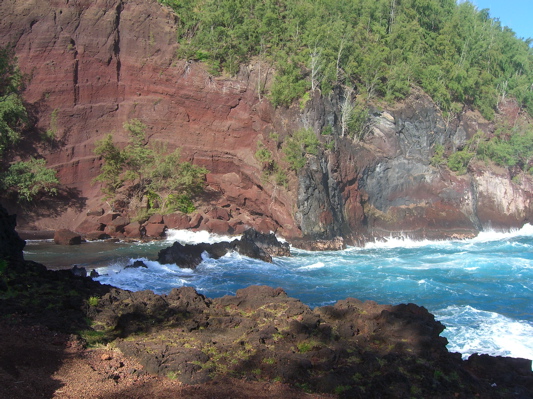
We changed into our bathing suits and headed over to the famous red sand beach down near the community center at the end of town. All of the books and things I’d seen said that you park your car at the end of the road and then walk down to the beach; various places had described it as “a slightly steep walk” on “a tricky cinder trail,” but that sounded perfectly doable.
It was not. If I told you it was a perilous long hike down a terrifyingly slippery and narrow “path” along the edge of a mountain with a thirty-foot drop down to rocks below you, you’d have a better idea of the trail. I kept stopping and begging to go back, but Robert kept trying the “we’ve come this far already” and “it’ll be fine, it’ll be fine” arguments. They barely worked. We finally got down there, and it was way too rough to even swim, never mind to snorkel. The beach was almost deserted, save for a woman with a four-year-old child. After awhile, as almost the entire beach was falling into shade, we saw them turn around and leave the beach, the woman carrying the child on her hip up that trail. By now I was sitting on the very end of the trail, just two feet or so above the beach, ready to go back up whenever Robert wanted. Just then, a crazy man from California walked down the path, and stopped when he got to me.
“’Scuse me, darlin’, I think I need to get by you.”
I ignored him. A) I’m not his darling. B) I was sitting on a tiny rock ledge pressed back against the mountain absolutely not moving.
“Darlin’?”
 Nothing.
Nothing.
“Okay, darlin’, I’ll just squeeze by.”
He did.
Eventually Robert decided that we could leave the beach, and eventually I was persuaded that climbing back up—even though it meant risking death—was better than starving to death by never leaving this beach. We made it back to the car, and then, since I was still traumatized by that terrifying, deathly walk, Robert offered to stop at the pick-your-own fruit place we’d seen earlier, driving by.
That was a mistake. First of all, just beyond the pick-your-own sign, we turned onto a scary, bumpy dirt road, barely wide enough for the car, and though we had misgivings, we continued down it because there was no place to turn around. In a clearing at the end of the road, with some falling-down shacks and lots of empty, upside-down soy sauce buckets, we saw more pick-your-own signs, and the ever-present-in-Hawaii wild chickens, but no people. I didn’t like the looks of the place, and I wasn’t getting out of the car.
Suddenly I remembered I’d read about this place, and while Robert is (still in the car) looking around for signs of life, I tried to tell him that what I’d read had sounded insane and not for us. “Off-the-grid, work-exchange, lifestyle, not just a casual pick some mangoes kind of place,” I muttered, quietly just in case we were being watched.
Apparently we were, because suddenly a man appeared behind us.
“Staying or leaving?” he demanded, wielding an avocado threateningly.
“Um, so we’d like to pick some nice ripe mangoes and things,” Robert said.
“Staying or leaving?” the man repeated.
“Are the mangoes ripe?” Robert subtly rolled up the windows for extra protection.
“Either get out of the car or turn around and go,” the man said, his words punctuated by growls from a dog I couldn’t see but was sure was rabid, standing next to him.
I was completely silent, wondering how best we could put the top up and/or flee, throughout this exchange.
“Um, okay, we’ll go,”
Robert said.
We turned around and drove out. The peril of the cinder trail is now, at least,
a distant memory compared to these crazy Deliverance-type people. You know,
that frightening man and his farm were less than a quarter mile from our rented
room. . . that didn’t help me sleep better that night, for certain.
Back in our room, we changed out of our (completely unneeded) bathing suits,
and at 5:00 we went out to poke into Hana Ranch Store and Hasegawa General Store.
Hana, in case this hasn’t sufficiently come across, is a truly small town:
there’s a bank that’s open about an hour a day (two on Fridays),
a post office, a gas station, two restaurants, two stores, two snack bars, and
that’s about it. I had been hoping for a place like Hilo, on the big island,
which I was completely enchanted by, but no, this is not as cool at Hilo or
even the funky hippie Paia.
Both of the stores in Hana are truly
general stores in the classic sense; we nosed around and bought several kinds
of marlin jerky and several kinds of li hing mui treats (more dried mangoes,
because we’d eaten all of them, and sour gummy watermelons, because things
just can’t be too sour).
We decided to go to the Hana Hotel restaurant for dinner—really it’s
the only place to eat, as far as we could tell; we sat at a table in the bar
and ordered a Waikaloa Breeze (a frozen drink with strawberries, cream, passion
fruit, pineapple, coconut, and rum), a small mixed greens salad from the bar
menu which came with papaya, pineapple, star fruit, and baby strawberries—you
could add a piece of the grilled fish of the day to the salad for a reasonable
amount, so we added it, and we loved the mahi-mahi—it was juicy and perfectly
cooked, with a nice peppery crust; we also had a small order of furikake-crusted
french fries and an order of ono sashimi. Everything was good, very fresh and
nice, but not great—the sashimi needed better presentation and perhaps
an extra sauce; the salad needed something like crumbled goat cheese and a more
assertive dressing; the fries needed a more interesting sauce, maybe a Thai
sweet chili sauce. Still, for an only-choice restaurant in a very small town,
it was a very good meal.
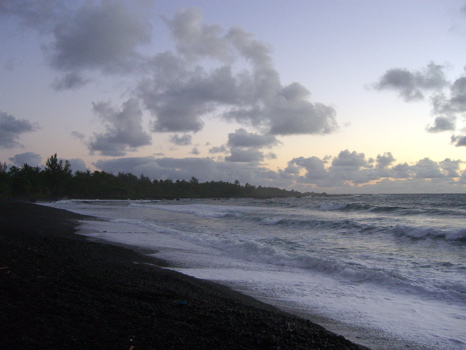
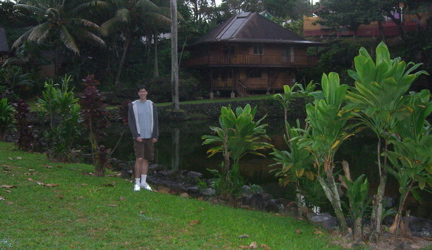
Pictured above, the beach behind our room, and Robert standing near the fishpond (the low stone wall). Back in our room, we fell asleep at 7:30, exhausted from our twin afternoon traumas.
Go back to web essays or over to links.
robertandchristina.com was made with a Mac.
© 2007 C&R Enterprises
Email christina@robertandchristina.com or robert@robertandchristina.com
Created: 12/26/06. Last Modified: 12/26/06